|
|
Post by cobber on Feb 5, 2008 9:42:08 GMT 10
This information regarding the Aurora caravan is taken from the 1948-49 edition of “The Caravan & Touring in Australia” (No 2) magazine published by Motor Manual. If you have any further information on this brand please add it to this posting. 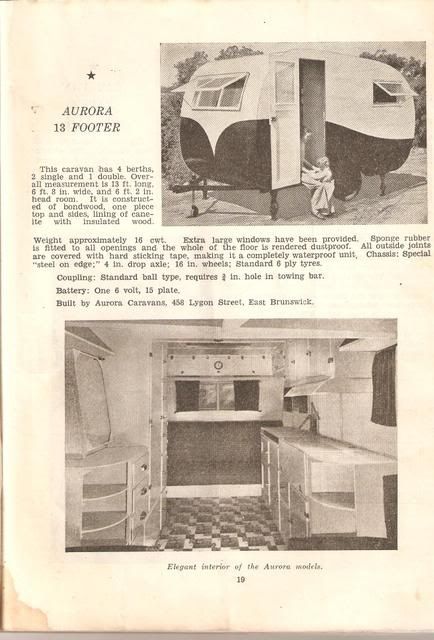 Cobber.
ADDENDUM - March 2023 by Don Ricardo: Photo of the kitchenette of an Aurora caravan from a different angle, printed in the 1948 Winser Caravan manual: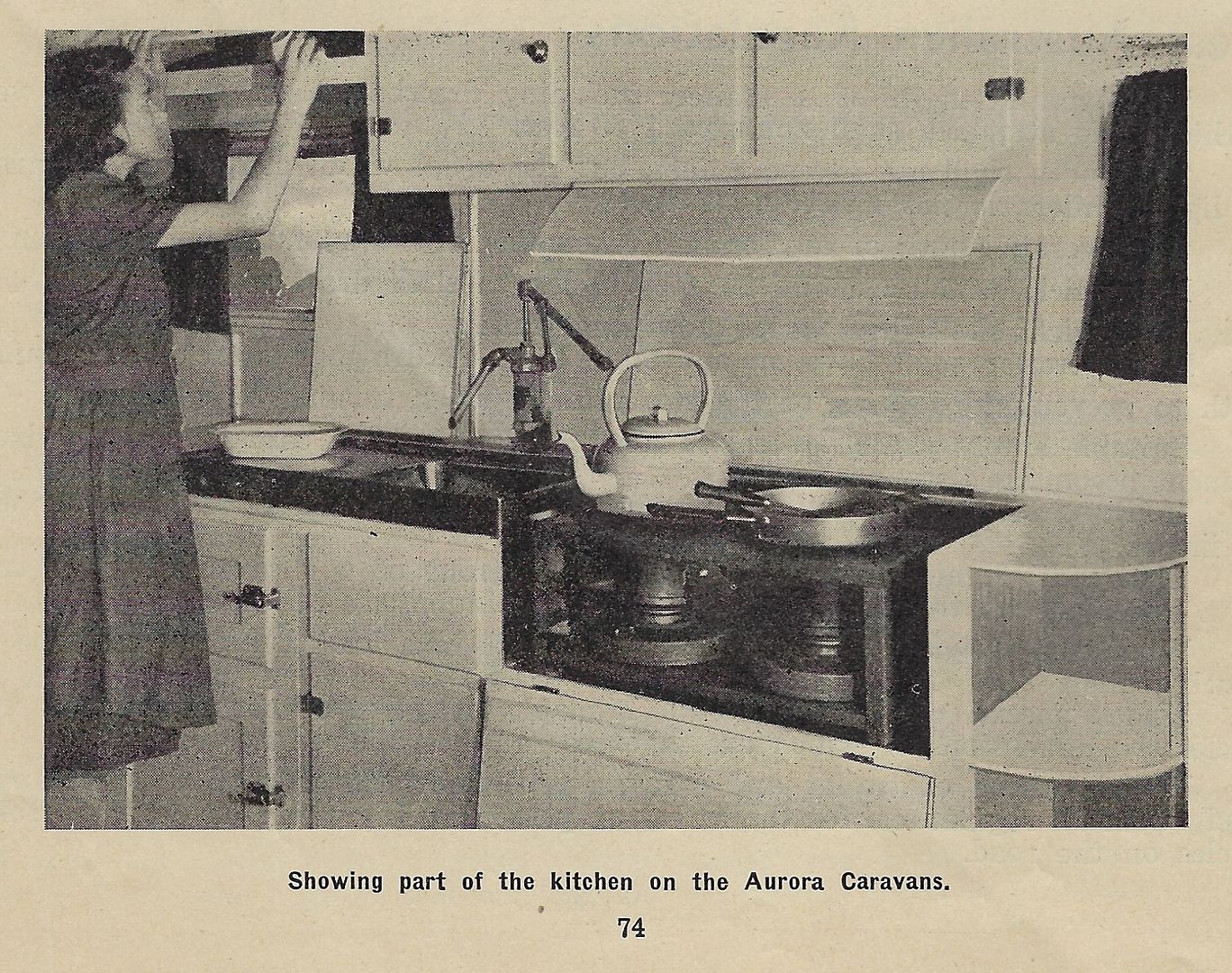 (Source: K Winser, The Caravan & Touring in Australia, 1948, page 74) |
|
|
|
Post by Don Ricardo on Oct 19, 2013 13:35:20 GMT 10
1948 classified advertisements, including one for Aurora caravans, posted by Franklin1 on 23 April 2008: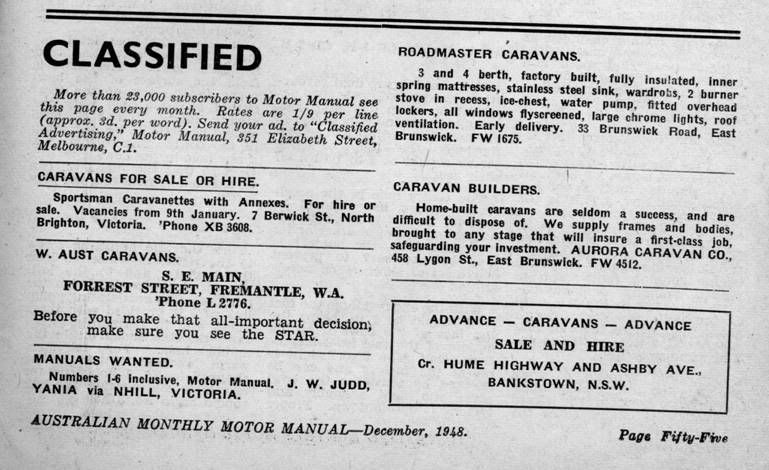
|
|
|
|
Post by drivinglights on Oct 23, 2013 17:18:59 GMT 10
Hi Gentlemen. Thanks to Sue who I met at Lake Goldsmith for pointing me in in your direction. My grandfather, William Smith was the owner and builder of Aurora Caravans. It's a bit blurry, but I think that the lady in the picture above is my grandmother, Joan. I have a couple more photos of the vans which I will try to find and post.
|
|
|
|
Post by cobber on Oct 23, 2013 18:00:39 GMT 10
G'day drivinglights, Good to hear from you, we love getting in touch with relos of the pioneers of the caravan industry in Australia. As you can see we don't know a lot about Aurora caravans so any photos and information you can provide will be much appreciated. Do you know for how long your grandfather was involved in the industry and how many models of the Aurora were made ? I posted the above photo in 2008, since then I've acquired a newer scanner so I'll see if I can post a clearer copy so you may be able to say for certain sure if it is your grandmother sitting on the step..... Who do you think the child might be ?  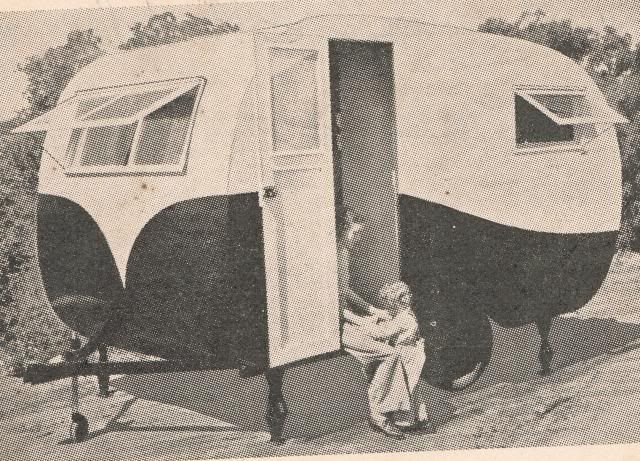 Cobber |
|
|
|
Post by Don Ricardo on Oct 26, 2013 17:01:24 GMT 10
Hi Drivinglights, I second Cobber's welcome to you! It is great when we hear from a family member of one of the caravan pioneers. I thought you might be interested in seeing some of the adverts for Aurora caravans which were placed in the Melbourne Argus newspaper. This is just a selection I've found, but of course many of them were re-printed in the paper regularly over the years. The first I have found was printed on Friday, 13 October 1939 (p 11), which was about a month after the start of World War II. The advert refers to frames and bodies, but I presume Aurora was also producing complete caravans:  (Source: National Library of Australia nla.gov.au/nla.news-article11260326 ) Similar adverts appeared in the Argus up until 1941, after which nothing appeared until September 1946, a year after the end of the War. This one was printed on Saturday, 14 September 1946, (p 32):  (Source: National Library of Australia nla.gov.au/nla.news-article22331988 ) This advert printed on Saturday, 7 December 1946 (p 32) tells us a bit more about what was included in the Aurora vans:  (Source: National Library of Australia nla.gov.au/nla.news-article22389272 ) On Thursday, 6 February 1947 (p 15), a new briefer advert appeared which ran through until the early 50's. It emphasised that Aurora vans were new, modern and contained every comfort:  (Source: National Library of Australia nla.gov.au/nla.news-article22406924 ) Then on Saturday, 29 November 1952 (p 32), Aurora began to advertise that they had caravans to hire: 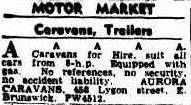 (Source: National Library of Australia nla.gov.au/nla.news-article23201780 ) The last mention of Aurora caravans in the Argus newspaper appeared on Monday, 12 October 1953 (p 8), when an item appeared in an "advertorial":  Just so that you can read it    , the Aurora item is as follows:  (Source: National Library of Australia nla.gov.au/nla.news-article23309491 ) I note that this item refers to two addresses for Aurora - 458 Lygon Street, East Brunswick and also 1483 Malvern Road, Malvern. So, it appears from the above that your grandfather was producing caravans from at least 1939 through to 1953, which is a reasonable stretch given the tumultuous events of that period. It will be fantastic to hear what you have to tell us about him and his activities, as well as to see whatever photos you may have. It is just so good when we can fill out the picture of some of the early caravan manufacturers such as your grandfather.    Don Ricardo |
|
|
|
Post by drivinglights on Jan 2, 2014 16:42:19 GMT 10
Hi Gentlemen, thank you for the warm welcome! (and apologies for my tardiness in replying!  ) Thank you Don for your research on Aurora advertising, too. Fascinating to see these little time-capsules, forgotten parts of my grandparents' world. My grandfather (William Smith) was from Leeds. He started life in Australia in the timbermills around Kerrisdale, near Seymore. Trained as a draftsman and builder, he worked in a variety of areas, finally building himself a caravan to live in while he worked on far-flung projects such as wheat silos. He sold the car and van and started-up Aurora vans in 1936 at the address above, 458 Lygon Street. (He bought the land and had the factory built.) The building still stands. The front is now a bridal / dress shop and the rear is a dance studio. The small rooms along one side which are now offices / bathroom are the remains of the small unit-style living quarters he built and in which he, my gran (Joan) and later my mum Carrol lived. There are still gorgeous etched-glass doors in the building from "back in the day." Gran believes Aurora were the first professionally produces 'vans in Australia - certainly in Melbourne. A few years later Don vans in Dandenong started up and then Romany Road, however she recalls that Romany Road went broke so for many years it was just Aurora and Don. They ran the business until 1963, after which they stopped producing vans and started a hardware store. Aurora vans were produced with a laminated timber frame, clad inside and out with ply. The outside was then covered again with calico and this bonded into the skin with special paint. Grandad sold and leased vans, with two versions predominating; a 10' three-berth and a 12' four-berth, both featuring fold-out beds, metho or gas stoves, watertanks and sinks. In the ads above, the lady sitting in the doorway is Joan and the toddler is Carrol.  |
|
|
|
Post by drivinglights on Jan 2, 2014 17:26:41 GMT 10
|
|
|
|
Post by drivinglights on Jan 2, 2014 17:33:46 GMT 10
|
|
|
|
Post by drivinglights on Jan 5, 2014 10:02:40 GMT 10
Here's another pic: A 10' van being towed with Gran in the passenger seat and Mum just visible in the shadows. 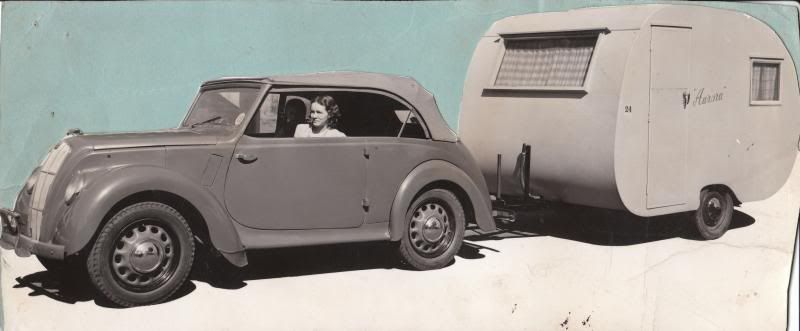 This one is a nice detail shot of the interior, taken for a brochure: 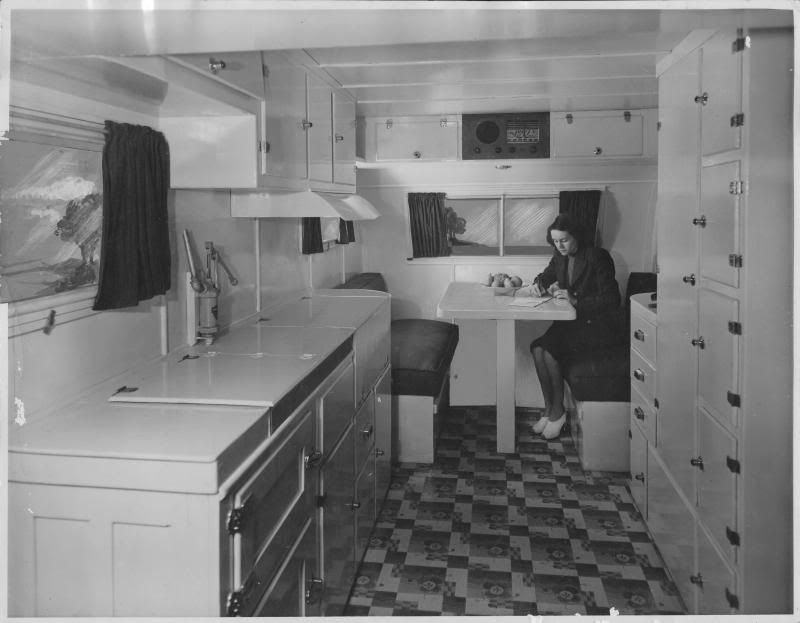 And lastly, a blurry old copy of a newspaper article circa 1952. Grandad modified one of his 10' vans to be a knock-down kit. The whole van fitted flat-packed between the chassis rails, making box of roughly 10' x 5' x 18" for shipping to the UK to be used fo a holiday "back home." 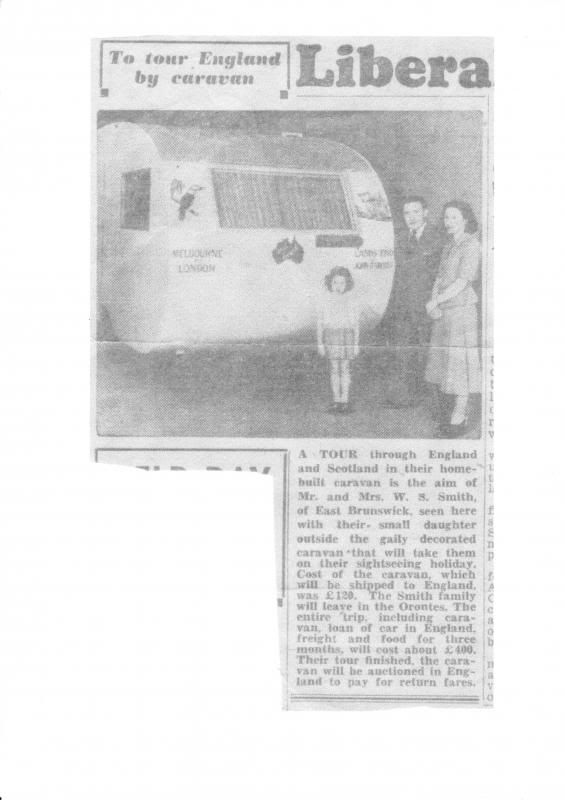 |
|
|
|
Post by cobber on Jan 5, 2014 10:23:28 GMT 10
G'day Drivinglights,
All good stuff mate, thanks for posting those photos and telling us some of the history of the firm.
Do you know if the proposed tour of the UK in an Aurora caravan actually took place ? It would be interesting to follow that up if it happened.
Cobber.
|
|
|
|
Post by drivinglights on Jan 5, 2014 10:33:20 GMT 10
Cheers, Cobber.
Yes, it happened. There were resulting stories of Mum being chased by cows when they camped in a field and Grandad riding a London bus with a cylinder-head resting in his lap after the tow-car died. I'll see if Gran has any more anecdotes.
Also, have remembered that the Malvern address was an agency run by Jack Peacock, Grandad's nephew. I think Jack's place was mostly concerned with hiring vans rather than selling them.
|
|
|
|
Post by cobber on Jan 5, 2014 10:59:09 GMT 10
Gee wouldn't it be good if an Aurora caravan came out of a shed somewhere as a result of this thread  Too many antidotes about the tour in England won't be enough ... keep 'em coming   Cobber. |
|
Deleted
Deleted Member
Posts: 0
|
Post by Deleted on Jan 5, 2014 14:15:11 GMT 10
Hi drivinglights.
Were Aurora caravans made or sold under any other manes ??
Jill.
|
|
|
|
Post by murray on Jan 5, 2014 15:21:47 GMT 10
Certainly a wonderful photo of the interior of the Aurora van.
A large array of different cupboards and a built-in radio !!!.
Love the scenes up at the windows .....nice touch for the brochure ;D
Cheers
Murray
|
|
|
|
Post by Don Ricardo on Jan 5, 2014 21:24:08 GMT 10
Hi Drivinglights, Thank you so much for posting all those photos and stories about your grandfather's Aurora caravans. As I seaid earlier, it really is fantastic to learn a bit more about some of the people and companies which pioneered caravan building in Australia, particularly those that we don't know a great deal about at this point, such as Aurora. It is especially cool to know that the lady and child in the first photo on this thread are your grandmother and mother.    Also fascinating to see a clearer photo of the inside of the van which speaks of obvious quality, and to read about your grandparents' trip to the UK with one of their vans. Flat pack - why didn't I think of that when I wanted to holiday overseas with my van? ;D ;D ;D Regarding the photos of the van at the Shell service station in Reply #7 above, I think that those were taken at Mannum in South Australia on the River Murray where there is a ferry across the river. It is very interesting to learn about when your grandfather started his business and how long it kept going - both earlier and later respectively than we were previously aware. There were actually quite a few more commercial caravan builders in the early 30's (and even 20's) than your grandmother may have been aware of - Windmill, Land Cruiser, and Wolfenden as well as Don in Melbourne for example, and others in other states such as Caravan Park in NSW - however, she is quite right in saying that many, indeed most, of these did not survive, or did not re-start after WW II. Of the Melbourne based manufacturers Windmill, Land Cruiser and Wolfenden didn't re-commence building vans again even though they were each quite significant manufacturers producing relatively large numbers of vans in the 30's. The fact that Aurora, along with Don, did start up again after WW II probably says something about your grandfather's tenacity, drive and vision as well as his business sense. You mention that your grandfather continued his caravan business up until 1963. Was he still building new vans at that point, and if so, did he change the shape or style at all? I haven't been able to find any additional info on Aurora apart from what was posted above by Cobber and I, so the info you are sharing with us just helps so much to fill out the picture we have of your grandfather's work and legacy. As Cobber says, it will be great if this discussion results in an Aurora van being discovered in someone's shed.    Let's hope so! Don Ricardo |
|
|
|
Post by drivinglights on Jan 18, 2014 16:08:16 GMT 10
Jill,
Aurora vans were only ever hired/sold under that name.
Early vans were the ply-and-canvas as described above, but by the end they were making aluminium vans.
Cobber,
Mum recalls that the holiday was a great success, touring around long before the advent of caravan parks as we know them. The usual procedure each night was to use a roadside lay-by, or the turn-in for a field. Even better was to find the farmer and ask if they could use a corner of a paddock. This resulted in Mum being chased by cows on more than one occasion!
In the pic above, you can see a kookaburra, koala and map of Australia on the van. These were cut out in ply, painted and screwed on, however they didn't last the trip.... Curious and well-meaning locals were knocking on the door every time the family stopped wanting to talk about Australia and the trip, usually just at dinner time. In the interests of privacy Grandad removed them.
The flipside to this is that my grandfolks met some wonderful people, especially the farming families who allowed them to camp in a corner of their field. The children of a couple of these families still send Grandma Christmas cards.
|
|
|
|
Post by cobber on Jan 18, 2014 18:46:56 GMT 10
G'day drivinglights,
That tour of the UK in 1952 by your Grandparents and mother in a caravan that your Grandfather built himself would have been an adventure not to be forgotten.... that is for certain sure 
Thank your mum for sharing it with us please
Being 1952 they preempted another similar type of tour in 1958 that we are aware of by a family in a Jennison caravan ( which they did not build themselves) so your family can claim to have set a trend aye ?
English caravan parks then ( and even now I suspect ) were not up to the standard we enjoyed here at that time, but never-the-less camping in a farmers paddock takes a lot of beating. I spent the night of my 70th birthday doing just that on the way home from the Mount Gambia  Gambier Nationals in 2008 Gambier Nationals in 2008  
I wonder if the southern 'Aurora' is still tripping around the old dart ?
Cobber.
|
|
|
|
Post by drivinglights on Jan 25, 2014 14:53:39 GMT 10
I asked Gran the other night about the trip, Cobber. She recalls that one night some sort of health inspector turned up on their doorstep (footplate? running board?) and asked to have a look around. He was very impressed with the layout, which included a camping toilet mounted on the drawbar with a tent-style device mounted around it when set up for the night. Not all people were so friendly however, with the family being "moved on" one afternoon by a landowner who objected to them stopping on the roadside for a cuppa. Seems he owned the land right up to the road itself and didn't want travellers - Australian or otherwise - stopping on his turf.
At the end of the trip my Grandfather was quite disillusioned and frustrated with the "petty small-mindedness" that was overtaking post-war UK and couldn't wait to get home. Unfortunately, berths from the UK to Aus were at a premium because of the migration demand. Fortunately, one of the farmers who had befriended them "knew a man" at the docks...some papers were shuffled and they managed to jump the queue and come home. No mean feat since the "queue" was nearly 12months long!
As for the caravan, as you mention, the caravan industry in the UK was in its infancy and there was simply no demand for the Smith family 'van. Rather than leave it to rot, Grandad broke it down to its flat-pack form again, stuck it back in its box and took it home where he promptly sold it.
On the plus side, while in the UK, Grandad was reminded of the prevalence of gas lighting - a trend he decided to put to good use. He bought a whole-sale quantity of gas mantles and brought them home with him. As a result, post-war Aurora vans were fitted with gas lighting using proper lime-soaked mantles. This was something of a selling point since mains-power options were so limited for travellers.
During the war, demand for caravans was very low and materials were often scarce. Apparently the factory kept going with a line of "Wood Art" homewares - things such as sewing boxes, lamp-stands, dustpan & brush sets, etc, which were well-made and decorated. A particularly successful line was hand-painted lamp shades, sold by a distributor in Melbourne. At its height, the Wood Art sideline employed 6 artists hand-painting the items.
During this time, petrol was rationed, but metho was still readily available. The factory bought metho in 44-gallon drums for making the shellac used on the Wood Art products. Since the petrol ration was just 4 gallons a month, Grandad used some of the metho to stretch reserves a little further. Grandma recalls that the "procedure" for running the car involved tipping some precious petrol in the carby to get it started, then allowing it to run on the metho after that. "It didn't have the same go as petrol" she says, "but it was a beautifully clean-burning fuel and it was better than not having anything!"
The factory still built the odd van during the war, but could only complete them as supplies allowed. Gran told me that in trying to source plywood, she would be sent off to a particular timber yard to see a particular man and be told in hushed tones, "I can let you have 6 sheets, bring the car around the back."
From the start, construction of the vans was by a technique evolved from what Grandad had seen when he did some work at Essendon airport. He made jigs for the side frames and multiple slats were laid-down in the jig, overlapping to form laminated frames. These sides were stood up and the cross-pieces added to make the box shape. Covering the outer ply with calico and bonding it into the paint was a development of the doped-fabric "stressed-skin" technique used on aircraft bodies. With the laminated timber frame and calico covering the vans were apparently very strong in a "springy" sort of way. Gran tells of one rental customer who towed a van too quickly and managed to roll it on a sharp corner. It just bounced. Once a new hitch was fitted, the van was still intact enough to tow back to the factory for repairs without any dramas.
Hope this is interesting to people. I'll add more nuggets of information as they come to hand.
Do you know of any vintage-caravan repair specialists around the south-east of Australia? I might pester some of them to see if they have ever seen an Aurora.
Cheers,
drivinglights.
|
|
|
|
Post by Don Ricardo on Jan 25, 2014 22:09:20 GMT 10
Hi Drivinglights,
Thanks to you and your Gran for more fascinating insights into your grandfather's activities with his Aurora caravans.
So wonderful to read about the tour of the UK, your grandfather's way of dealing with the change of circumstances brought about by WW II, and the ways your grandparents stretched their petrol ration during the war. The latter was a reminder to me of the gas producer my father had on his car during this period. Well before my time, but smelly, cantankerous things I gather.
There aren't too many specialist commercial caravan restorers around. The only one I can think of in Victoria - which is where an Aurora is most likely to turn up - is Overlanda, who is a member of this forum. You could contact him, but I think if an Aurora does emerge from the shadows, the forum is where you are most likely to hear about it. Here's hoping for both your sake and the rest of the forum as well!!
In the meantime, we look forward to reading more nuggets of info as you come across them with your Gran.
Don Ricardo
|
|